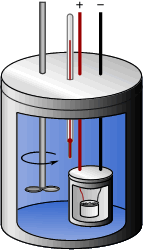- 01: Introduction
- 02: History
- 03: Propellants, Firearms, and Ammunition Development
- 04: Modern Firearms Manufacture
- 05: Small Arms Ammunition
- 06: Evidence Handling Procedures
- 07: Equipment and Instrumentation
- 08: Examination of Firearms
- 09: Cartridge and Shotshell Examination
- 10: Characterization and Evaluation of Fired Projectiles
- 11: Bullet Comparison and Identification
- 12: Gunshot Residue and Distance Determination
- 13: Toolmark Identification
- 14: Communicating Results
- Resources


Testing, Grading, and Blending
Home > Small Arms Ammunition > Components > Testing, Grading, and Blending

Calorimeter bomb
Click for larger imageEach new batch of propellant is tested for performance against a retained reference lot of that propellant. The reference lot is generally the first successful lot produced.
Laboratory testing involves a calorimeter bomb, which is a closed, fixed-volume vessel used to measure heat production from a known mass of flammable material. The new lot of powder is tested in the calorimeter bomb and its heat production compared to that of the reference lot. If the heat production tests match the reference lot (within a small tolerance), the new batch moves to ballistic testing.
For each propellant type or grade developed, a number of cartridges are loaded with the reference lot. The critical assembly information for these cartridges is carefully recorded along with the pressure and velocity results. A sample of each new batch is loaded exactly like the reference loads and tested for pressure and velocity. If the results match those of the reference lot (within a small tolerance), the new batch is approved for packaging and shipment.
Ballistic testing reflects the potential use of each propellant. For example, some propellants are suitable for both shotshell and handgun cartridges. They would be tested in cartridges appropriate to each type of firearm.
If the new batch fails to meet either heat production or ballistic tests, existing samples of powder with faster or slower energy release rates may be blended with the new batch to adjust the performance to meet specifications.




